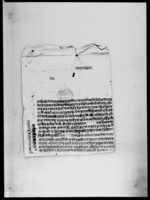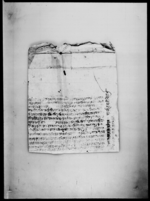A lālamohara from King Raṇabahādura to Lakṣmīnārāyana Putuvāra re the reward for building a dasaĩghara (VS 1849)
ID: K_0625_0039
Edited and
translated by Astrid Zotter
Created: 2017-03-24;
Last modified: 2018-06-15
For the metadata of the document, click here
The accompanying edition, translation/synopsis and/or commentary are available under the terms of the Creative Commons Attribution-ShareAlike 4.0 International License
Abstract
This lālamohara of King Raṇabahādūra announces a reward for Lakṣmīnārāyana Putuvāra for having built the dasaĩghara at the Mūlacoka of Kathmandu palace. It includes a garment of honour, money, and a land grant (birtā) to establish a guṭhi for the purpose of providing beaten rice (ciurā) to Brahmins serving Paśupatinātha in the month of Vaiśākha and to mendicants.Diplomatic edition
[1r]
[...]हाय\⟪1⟫श्रीपशुपतिनाथःशिव[royal seal]1स्वस्तिश्रीगिरिराजचक्रचूडामणिनरनारायणेत्यादिविविधविरुदाव2लिविराजमानमानोन्नतश्रीमन्महाराजाधिराजश्रीश्रीश्रीमहाराजेर
3णवहादूरसाहवहादूरसम्सेर्जङ्देवानाम्सदासमरविजयिनाम्
4आगे•लक्ष्मीनारायनपुतुव़ारके•सेहरकाठमाडौको•मूलचोककोदसै
5दसैंघरवनायाकोइनाम•सरसिरोपाव़कोहुँदो•औ•महिंद्रमलिरुपै
6याचारसयएक•पत्थरकलावंदुक्आठसलामिलिकिर्त्तिपूरको
7काडोलकाषेतमध्ये•रोपनिपचहत्तरी७५¯ ¯ ¯ ¯ ¯कन•वैसाषमा
8जलचर्हाउन्या•व्राह्मणके•जनहि•कुरुवाएकचिहुरादिकन•से
9षरह्याको•फकिरफुकरालाइदिनुभनिगुठिराषनानिमित्य
10विर्त्तागरिवक्स्यौं•एस्¯ ¯निर्माल्यमाकालकालालक्ष्मीनारायन
11कासन्तानले•अरुकसैले•गुठमेट्नलोभराषनामापस्यापंचमहा
12पातक•लोभनराषिवनाउनामापस्याउत्तरोत्तरवृद्धि•हवस्आफ
13नाषातिर्जामासितगुठराष•सदावर्त्तचला•इतिसंवत्१८४९साल
14आषाडशुदि२रोज५मुकामकांतिपूरराजधानिशुभम्¯¯¯¯¯¯1मार्फत्श्रीकृष्णसाहः
2रुजूशक्तिवल्लभमहाचार्यः
[1v]
मार्फतषजंचिगर्भुTranslation
[1r]
[May] Śrī Durgā help [us]!
Śrī Paśupatinātha
Śiva
[royal seal]
Hail! [A decree] of him who is shining with manifold rows of eulogy [such as] "The venerable crest-jewel of the multitude of mountain kings" and Naranārāyaṇa (an epithet of Kṛṣṇa) etc., high in honour, the venerable supreme king of great kings, the thrice venerable great king, Raṇabahādūra Sāha, the brave swordsman, the divine king always triumphant in war.
Āge: to Lakṣmīnārāyana Putuvāra.
As a reward for having built the dasaĩghara for the Dasaĩ[-rituals] of the Mūlacoka of Kathmandu City, we [herewith] grant for [his] well-being (hũdo) a full siropāva-garment and 401 mahendramallī (text: mahiṃdramali) rupees while receiving an eight-gun (lit. "eight-flintlock") salute; [in addition,] 75, [in words] seventy-five, ropanīs of wet-rice fields (kheta) of the Kāḍola [neighborhood?] of Kirtipur as a birtā in order to set up a guṭhi for the purpose of giving to mendicants (phakiraphukarā)1 what remains after giving one kuruvā of flattened rice (ciurā, text:cihurā) to the Brahmins who offer water to [Śrī Paśupatinātha]2 in [the month] Vaiśākha.
May the sin of committing [one of] the five heinous crimes (pañcamahāpātaka) [fall on] Lakṣmīnārāyana's descendants or anyone else who, [in] the future (kālakālā for kālakalā), becomes involved in coveting [funds] in order to wipe out the guṭha in [connection with] this bathing water (nirmālya)3 of [Śiva];4 [but] supreme growth [for him who] becomes involved in building/repairing [work] without coveting. Establish the guṭha [and] conduct the regular food distribution (sadābarta), being mindful of your duty (āphanā khātirjāmasita).
Thursday, the 2nd of the bright fortnight of Āṣāḍha in the [Vikrama] era year 1849 (1792 CE). Residence: Kantipur,5 the capital. Auspiciousness.
Through (mārphat) Śrīkṛṣṇa Sāha
Attested by (ruju) Śaktivallabha Mahācārya
[1v]
Commentary
Copies of this lālamohara are extant as K_0087_0002 (of the Paśupatinātha Jāla Guṭhi po. 5, certified by bahīdāra Najaramāna? from Naradevīṭola) and K_0498_0007 (Po. no. 16 Gu. Bam., certified by someone from Naradevīṭola whose name is illegible, but ends with Putuvāra). Follow-up documents on the guṭhi established by this lālamohara are extant as K_0305_0026 (VS 1974) and K_0625_0040 (VS 1974).
The present document grants Lakṣmīnārāyana Putuvāra high honours. The garment of honour (siropāva) was given to newly appointed persons or to those who performed extraordinary tasks for the king (Krauskopff/Meyer 2000: 122-123). Was the building of a royal dasaĩghara such a service, or is it and the gun salute somehow also connected with the favour supposedly shown by Pṛthvīnārāyaṇa Śāha to the Putuvāras (also called Ḍuṅās or Rājavāhakas), a low Newar caste of porters? The vaṃśāvalīs record that a Putuvāra helped Pṛthvīnārāyaṇa to escape death during his first assault of Kirtipur. Because he saved the king's life by carrying him back to Nuvakot, the Putuvāras became "close to the king" (Bajracharya/Michaels 2016: 114, 134; Hasrat 1970: 90).
The service Lakṣmīnārāyana Putuvāra was rewarded for, namely the building of the dasaĩghara at the Mūlacoka, seems to have been part of a broader renovation scheme of Hanumānḍhokā palace under King Raṇabahādūra (for which see Slusser 1998: 198). Even if it cannot be ruled out completely that the dasaĩghara mentioned in the present document was located elsewhere in or around the Mūlacoka, it is likely to be the dasaĩghara (or a predecessor of it) adjacent to the eastern side of this courtyard (G. Vajrācārya 1976: 120-121), the exact period of whose construction remains unknown. The only dated item at the building is a bell which, according to its inscription, was donated by Queen Suvarṇaprabhā in VS 1859 (1802 CE; G. Vajrācārya 1976: 267; Dh. Vajrācārya/Śreṣṭha 1980: 352-353). Having studied its architecture, N. Gutschow (2011: II, 344-345 no. 29) assigns this building to the 20th century. The completion of the building the present document talks about can be pinned down to the year 1792.
As G. Vajrācārya has stressed, the dasaĩghara of Hanumānḍhokā is the only one of its kind added under the Śāhas to an old Malla palace. That this was probably part of a broader scheme to appropriate the palace and to re-adjust the courtly rituals to the needs of the new dynasty can also be inferred from the fact that "Śaktivallabha Mahācārya" signed the document. Śaktivallabha Arjyāla had been the king's purohita since Pṛthvīnārāyaṇa's time. He also composed court poems. In the same year the present document was issued he finished the Jayaratnākaranāṭaka (published as Arjyāla 1957).


